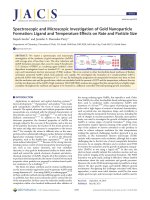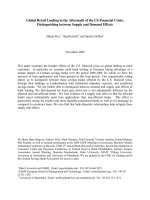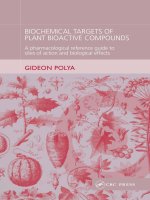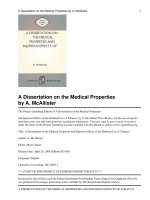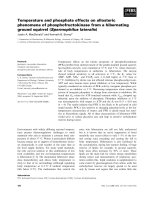Evalution of anti-inflammatory and bronchodilator effects of Dinh Suyen P/H extract on experimental animals
Bạn đang xem bản rút gọn của tài liệu. Xem và tải ngay bản đầy đủ của tài liệu tại đây (335.22 KB, 9 trang )
JOURNAL OF MEDICAL RESEARCH
EVALUTION OF ANTI-INFLAMMATORY AND
BRONCHODILATOR EFFECTS OF DINH SUYEN P/H
EXTRACT ON EXPERIMENTAL ANIMALS
Nguyen Thi Chau Loan1, Pham Thi Van Anh2, Pham Vu Khanh3,
Nguyen Thi Thanh Loan2
1
Thai Binh University of Medicine and Pharmacy,
2
Department of Pharmacoloy, Hanoi Medical University,
3
Ministry of Health of Vietnam
The purpose of this study was to evaluate the anti-inflammatory and the bronchodilator effects of
Dinh Suyen P/H extract in experimental animals. The anti-inflammatory activity of Dinh Suyen P/H
extract was evaluated in an induced peritoneal inflammation model in rats and amiant-induced
granuloma model in mice. To evaluate the bronchodilator effect, the bronchospasmolytic activity
in anesthetized guinea pig model was used. The present study demonstrated that Dinh Suyen
P/H extract at dose 6.22 g/kg per day and 18.66 g/kg per day inhibited acute inflammatory activity
in rats. The results obtained in the amiant-induced granuloma in mice did not show evidence of
chronic anti-infammatory effect of Dinh Suyen P/H extract at dose 12.44 g/kg per day or 37.32 g/
kg per day. In addition, the findings of this study indicated that Dinh Suyen P/H extract at dose 8.29
g/kg per day inhibited the bronchocontriction in bronchospasmolytic activity in a guinea pig model.
Keywords: Dinh Suyen P/H extract, anti-inflammatory, bronchodilator
I. INTRODUCTION
Asthma affects an estimated 300 million
individuals worldwide. It is a serious global
health problem affecting all age groups, with
increasing prevalence in many developing
countries, rising treatment costs and a rising
burden for patients and the community
[1; 2]. Inhaled corticosteroid is the most
effective anti-inflammatory medications for
persistent asthma. When a medium dose of
inhaled corticosteroid alone fails to achieve
good symptom control, the addition of a
Corresponding author: Nguyen Thi Thanh Loan, Department of Pharmacoloy, Hanoi Medical University
Email:
Received: 27 June 2017
Accepted: 16 November 2017
44
long-acting beta 2 agonist bronchodilator
improves
symptoms,
lung
function
and reduces asthma exacerbations. In
addition, inhaled short-acting beta 2
agonist bronchodilators and short-acting
anticholinergics are medications of choice
for acute relief of asthma symptoms and
bronchoconstriction [1; 3; 4].
Currently, phytotherapy is gaining
popularity. The use of complementary
traditional herbal medicines in the treatment
of various diseases has expanded rapidly in
both developed and developing countries.
This rapid expansions is attributable to
affordability, accessibility and efficacy [5; 6].
The traditional remedies, Hebra Ephedrae,
JMR 111 E2 (2) - 2018
JOURNAL OF MEDICAL RESEARCH
Rhizoma Pinelliae, Fructus Schisandrae,
Folium Eriobotryae, Radix Glycyrrhizae,
and Rhizoma Zingiberis can help relieve
asthma [7 - 9].
Dinh Suyen P/H extract contains
the abore cemedies, and is a traditional
medicinal formula used in the treatment
of asthma. The present study hoped
to evaluate the anti-inflammatory and
bronchodilator effects of Dinh Suyen P/H
extract in experimental animals.
II. MATERIALS AND METHODS
1. Materials
Plant materials
A bottle of 250mL Dinh Suyen
P/H contains 20g Hebra Ephedrae,
30g Rhizoma Pinelliae, 20g Fructus
Schisandrae, 20g Folium Eriobotryae,
20g Radix Glycyrrhizae, 6g Herba Asari
sieboldi, 20g Rhizoma Zingiberis, 20g
Semen Armeniacae amarum, 20g Bulbus
Fritillariae, 20g Pericarpium Citri reticulatae
perenne, and 20g Ziziphus mauritiana. All
herbal materials were decocted in water to
obtain 40g Dinh Suyen P/H extract.
Dinh Suyen P/H was provided by
Phuc Hung Company Limited, and meets
the pharmaceutical quality standards of
manufacturers.
Experimental animals
Wistar albino rats weighing between
180 gram – 220 gram and Guinea pig
weighing between 350 gram – 400 gram
were obtained from animal center of Đan
Phuong, Ha Noi, Viet Nam. Swiss albino
mice weighting between 18 gram – 22 gram
were obtained from the National Institute
JMR 111 E2 (2) - 2018
of Hygiene and Epidemiology, Hanoi,
Viet Nam. The animals were allowed an
acclimatization period of 7 days to laboratory
conditions prior to the initiation of the study.
They were maintained for 12 hours in light
and dark cycle in a well ventilated house,
with free access to food and water ad
libitum.
2. Methods
Induction of Peritoneal Inflammation
(Peritonitis) in Rats:
A total of thirty Wistar albino rats were
divided into four groups of ten animals each
[10]. The animals were orally administered
one of the following solutions:
- Group 1 (control group) served as the
vehicle control and received 1 ml/100g per
day sterile distilled water;
- Group 2 (positive control group) were
orally administered methylprednisolone at
dose 10 mg/kg;
- Group 3 (treated group) were orally
administered Dinh Suyen P/H extract at
dose 6.22 g/kg per day;
- Group 4 (treated group) were orally
administered Dinh Suyen P/H extract at
dose 18.66 g/kg per day.
Carrier solution, methylprednisolone and
Dinh Suyen P/H extract were administered
daily for a period of 5 days to all animals.
One hour after treatment on the 5th
day, rats were injected intraperitoneally
into peritoneum with 1ml/100g of 0.05%
carrageenan and 1.4% formaldehyde
suspension in 9‰ sodium chloride. After
24 hours, the animals were killed and
the peritoneal cavity exposed. Peritoneal
exudates were collected by aspiration
45
JOURNAL OF MEDICAL RESEARCH
and the volumes recorded; the amount of
leukocytes per 1 ml exudation were counted
and protein in the exudation quantified. The
difference of the average values of these
parameters was calculated and compared
to the control group.
Amount of leukocytes were quantified
using automatic hematological analyzer
Exigo - Boule Medical AB. Total protein
content was quantified using biochemical
analyzer Erba Chem.
Amiant-induced granuloma in mice
Mice were divided into four groups of
ten animals [12]. The animals were orally
administered one of the following solutions:
- Group 1 (control group) served as the
vehicle control and received 0.2 ml/10g per
day sterile distilled water;
- Group 2 (positive control group) were
orally administered methylprednisolone at
dose 20 mg/kg per day;
- Group 3 (treated group) were orally
administered Dinh Suyen P/H extract at
dose 12.44 g/kg per day;
- Group 4 (treated group) were orally
administered Dinh Suyen P/H extract at
dose 37.32 g/kg per day.
A sterilized amiant fiber weight 6 mg
(soaked in 1% carrageenan) was implanted
in the back of the neck of mice in different
groups. They were treated with Dinh suyen
P/H extract daily for consecutive 10 days.
One hour after treatment on the 10th day
after implantation, all mice were killed.
Then, the granulomas were removed.
After removing extraneous tissues, they
were dried overnight at 56°C and weighed.
The mean net dry weight of the pellets of
the groups, which was after subtracting
46
the initial weight of the pellet (6mg) was
calculated and compared to the control
group.
Bronchospasmolytic
activity
in
anesthetized guinea pigs model
Guinea-pigs were divided into three
groups of six animals. They were orally
administered one of the following solutions
before receiving histamine for 30 minutes
[12].
- Group 1 (control group) served as the
vehicle control and received 1ml/100 g per
day sterile distilled water;
- Group 2 (positive control group) were
orally administered salbutamol at dose 6
mg/kg per day;
- Group 3 (treated group) were orally
administered Dinh Suyen P/H extract at
dose 8.29 g/kg per day;
Guinea-pigs were anaesthetized with
pentobarbital and xylazin. The trachea
was cannulated by means of a two way
cannula, one arm of which was connected
to the respiratory pump and the other to
the transducer. Excess air, not taken up
by the lungs due to bronchospasm, was
measured and recorded on a polygraph.
The internal jugular vein was cannulated for
the administration of spasmogens and test
compounds.
The tracheal cannula was clamped
(equivalent to clamping the trachea) ̣to record
the maximum bronchospasm in millmeters
(Amax). Then after giving histamine 20µg/
kg
intravenously, the excess air was
recorded immediately to determine the
bronchial response to histamine (0’) and at
5’, 10’, ..., 60’ after histamine administration
(At). The percentage of bronchospasm was
JMR 111 E2 (2) - 2018
JOURNAL OF MEDICAL RESEARCH
calculated for each animal at each time
point where: Pt = (At/Amax)*100
Pt (%): the percentage of bronchospasm
at minute t
At (mm): the average respiratory
amplitude at minute t.
Amax(mm): the maximum respiratory
amplitide
Statistical analysis
Data was analysed using Microsoft
Excel software version 2007. The levels of
significance between the experimental group
and the control were made using student's
t-test. Image J, a public domain Java
image processing program, was analyzed
to measure the width of the respiratory
amplitude in bronchospasmolytic activity in
the anesthetized guinea pigs model. Data
are shown as mean ± standard deviation.
All data were considered significant at p <
0.05.
* p < 0.05; ** p < 0.01; *** p < 0.001;
compared with control group
Δ p < 0.05; ΔΔ p < 0.01; ΔΔΔ p < 0.001;
compared with positive control group
III. RESULTS
3.1. Anti-inflammatory effect
3.1.1. Acute anti-inflammatory effect
Table 1. The effect of Dinh Suyen P/H extract on volume, protein content,
and amount of leucocytes in inflammatory exudation
Group
Group 1
(Control group)
Exudate volume
(ml/100g)
Total amount of
leukocytes (G)
Total protein
content (mg/dl)
( X ± SD)
( X ± SD)
( X ± SD)
2.03 ± 0.50
35.52 ± 24.65
10.37 ± 3.82
Group 2
(Positive control group)
1.43 ± 0.71*
6.83 ± 5.28**
6.71 ± 3.75*
Group 3
(Dinh Suyen P/H extract
at dose 6.22 g/kg/day)
1.26 ± 0.62**
16.79 ± 12.66*Δ
7.14 ± 3.71
Group 4
(Dinh Suyen P/H extract
at dose 18.66 g/kg/day)
1.08 ± 0.94*
12.40 ± 12.97*
5.30 ± 4.79*
As shown in tabe 1, methylprednisolone at dose 10 mg/kg decreased significantly the
exudate volume, amount of leukocytes and protein level in inflammatory exudate when
compared to the control. Dinh Suyen P/H extract at dose 6.22 g/kg per day decreased
significantly the exudate volume and amount of leukocytes in inflammatory exudate compared
to the control group; but had a non-significant veffect on protein levels in inflammatory
exudation compared to the control group. Dinh Suyen P/H extract at dose 18.66 g/kg per
JMR 111 E2 (2) - 2018
47
JOURNAL OF MEDICAL RESEARCH
day also decreased significantly the exudate volume, amount of leukocytes and protein level
in inflammatory exudate compared to control group. No significant difference was observed
between groups treated Dinh Suyen P/H extract at dose 18.66 g/kg per day and the positive
control group treated with methyl prednisolone.
3.1.2. Chronic anti-inflammatory effect
Table 2. The effects of Dinh Suyen extract on the weight of granuloma
Group
n
Net dry weight of granuloma (mg)
( X ± SD)
Group 1
(Control group)
10
17.18 ± 9.93
Group 2
(Positive control group)
10
6.79 ± 3.74**
Group 3
(Dinh Suyen P/H extract at dose
12.44 g/kg/day)
10
14.49 ± 5.51 ΔΔΔ
Group 4
(Dinh Suyen P/H extract at dose
37.32 g/kg/day)
10
23.44 ± 8.51ΔΔΔ
Observing in table 2, methylprednisolone at dose 20 mg/kg per day caused a significant
reduction in the dry weight of granuloma when compared to the control group (p < 0.05). Dinh
Suyen P/H extract at at both doses did not reduce the dry weight of granuloma compared to
the control group (p > 0.05).
3.2. The bronchodilator effect
Table 3. Effect of Dinh Suyen P/H extract on bronchospasmolity activity
in a guinea pig model
Group 1
Control group (%)
Group 2
Positive control group (%)
98.15 ± 7.11
92.31 ± 6.39
80.9 ± 12.37
80.39 ± 11.68
77.26 ± 12.54
85.19 ± 12.08*
60.09 ± 12.5***
54.72 ± 14.85**
57.06 ± 12.24**
51.1 ± 14.03**
Group 3
Dinh Suyen P/H
extract (%)
97.51 ± 3.31Δ
74.47 ± 11.09**
66.34 ± 9.55*
73.17 ± 8.68Δ
69.89 ± 10.97Δ
25
30
35
40
75.3 ± 13.73
73.32 ± 14.23
62.81 ± 15.73
64.44 ± 17.76
51.75 ± 15,16*
52.02 ± 14,96*
53.86 ± 14.79
53.58 ± 14.47
62.76 ± 14.15
62.47 ± 10.83
59.61 ± 9.74
57.4 ± 9.85
45
61.05 ± 15.46
50.85 ± 13.8
57.36 ± 8.82
Group
Minutes
0
5
10
15
20
48
JMR 111 E2 (2) - 2018
JOURNAL OF MEDICAL RESEARCH
50
55
60
62.53 ± 7.42
52.61 ± 11.11
52.07 ± 8.38
46.86 ± 13.15
48.19 ± 12.94
42.84 ± 15.36
58.43 ± 7.43
56.99 ± 3.65
55.63 ± 3.53
Percent of bronchospasm (%)
120
Δ
100
*
**
*
80
Δ
Δ
***
**
60
**
Dinh Suyen P/H
**
*
Salbutamol
*
Control
40
20
0
his
5
10
15
20
25
30
35
40
45
50
55
60
Minute
Figure 1. Effect of Dinh Suyen P/H extract on bronchospasmolity activity
in a guinea pig model
The results in table 3 show that:
- The control group: Giving histamine at dose 20 µg/kg intravenously induced potent
bronchospasm immediately and the maximum bronchospasm of giving histamine was over
98 percent in comparison to clamping the trachea cannula. Then the bronchospasm showed
a decreasing tendency during 60 minutes of monitoring.
- The positive control group: The bronchodilator effect of salbutamol at dose 6mg/kg was
observed at all time points. The bronchospasm significantly decreased at minute 0 , 5, 10, 15,
20, 25 and 30 compared to the control group at same time points.
- The treated group: At minute 5 and minute 10, Dinh Suyen P/H extract at dose 8.29 g/
kg per day showed a bronchodilator effect by significantly decreasing the bronchospasm
compared to the control group. The extract preformed similarly to the salbutamol at these
times. At later time points, the extract did not show a brochodilator effect compared to the
control group.
IV. DISCUSSION
Inflammation is one of the most
important mediating processes in asthma
[1]. To determine the acute and chronic
anti-inflammatory efects of this extract, we
used a rat peritonitis model, induced by
carrageenan/formaldehyde and an amiantJMR 111 E2 (2) - 2018
induced granuloma model in mice.
Acute inflammation is characterized
by classical symptoms, including heat,
redness, swelling and pain. Edema
(swelling) is therefore a good measure of
experimentally-induced acute inflammation
49
JOURNAL OF MEDICAL RESEARCH
[12]. In experimental animals, peritonitis
can be induced by physiological mediators
of inflammation (histamine, bradykinin)
or nonspecific irritants (carrageenan,
formaldehyde).
The
structure
of
carageenan is a polysaccharide like a
bacterial capsular polysacharide. It can
induce acute inflammation by triggering
the release of inflammatory mediators
(histamine, serotonin, bradykinin). These
mediators increase vascular permeability
and prostaglandin production. This results
in a gradual increase in fluid leakage and
more cells migrating into the animal’s
peritoneal cavity, especially neutrophils
[13; 14]. Adding formaldehyde can increase
the volume of exudate. Carrageenan/
formaldehyde induced peritonitis is often
used in the study of acute inflammatory
process in Viet Nam [11].
Methylprednisolone is a synthetic
glucocorticoid used to reduce inflammation
in asthma. Multiple mechanisms mediate
in the suppression of inflammation by
glucocorticoids. They inhibit leukocyte
infiltration at the site of inflammation,
interfere with mediators of inflammatory
response, and suppress humoral immune
responses. The anti-inflammatory actions
of glucorticosteroids are thought to involve
phospholipase A2 inhibitory proteins,
lipocortins, which control the biosynthesis
of potent mediators of inflammation
such as prostaglandins and leukotriene.
Methylprednisolone is a powerful antiinflammatory
agent
[6].
Therefore,
methylprednisolone can be used as a
positive control drug in acute or chronic
inflammatory models.
50
The present study demonstrated that
the Dinh Suyen P/H extract had an acute
anti-inflammatory effect at dose 6.22 g/kg
per day and 18.66 g/kg per day. The extract
inhibited inflammation. Shown by reducing
the exudate volume, amount of leukocytes
and/or protein level in inflammatory exudate.
The
amiant-induced
granuloma
model was used to evaluate chronic antiinflammatory effects of Dinh Suyen P/H
extract. Thymus dependent antigen elicits
antibody production by B lymphocytes
with involvement of Th cells. Additionally,
these antigens can also induce the second
immune response (cell mediated immunity)
that involves mostly T lymphocytes.
The foreign body (cotton, amiant), once
implanted in the skin of animal produced
undifferentiated connective tissue around it.
The adhesion of macrophages, neutrophils,
fibroblasts and collagen leads to granuloma
formation. This amiant induced granuloma
model shows the proliferative phase of the
inflammation [13; 14].To test the chronic
anti-inflammatory effect, amiant-induced
granuloma was used in this study. The
results of this study showed that the extract
at dose 12.44 g/kg per day and 37.32 g/
kg per day did not show anti-inflammatory
effect due to non-reduction in the dry weight
of granuloma after treatment. In this study,
the chronic anti-inflammatory effect has not
been clearly demonstrated yet.
In the other studies, some compounds
in the extract
were found to inhibit
inflammation such as pseudoephedrine,
ephedroxan
(Herba
Ephedrae)
[8],
schizandrin (Fructus Schisandrae) [15],
glycyrrhizin (Radix Glycyrrhizae) [17],
JMR 111 E2 (2) - 2018
JOURNAL OF MEDICAL RESEARCH
gingerols, 6-shogaol (Rhizoma Zingiberis)
[18]. These compounds were known to
effect the activities of cyclooxygenase and/
or lipoxygenase, and PGE2 in inflammation
reactions, resulting in decreased production
of inflammatory mediators and
proinflammatory cytokines such as gingerols,
glycyrrhidin, and schizandrin [15 - 17].
Histamine is an important mediator of
acute allergic and imflammatory reactions.
It causes bronchoconstriction by activating
H1 receptors [4; 12]. Bronchospasmolytic
activity in anesthetized guinea pigs
permits the evaluation of a drug's
bronchospasmolytic effect by measuring
the volume of air, which is not taken by the
lungs during bronchospasm. Salbutamol is
a highly selective β2-adrenergic receptor
agonist that has a bronchodilator effect
[4]. It is used to as the positive control in
this study. The results of this study showed
that Dinh Suyen P/H extract at dose 8.29
g/kg per day had the bronchodilator effect
by inhibiting bronchospam at at minutes
5 and 10. Other studies have found that
some herbs in the 11-herb formula can
act as bronchodilators, such as Herba
Ephedrae (ephedrin, pseudoephedrin),
Rhizoma Pinelliae (ephedrin), Fructus
Schisandrae (schizandrin, schizandrol),
and Radix Glycyrrhizae (isoliquiritingenin)
[9; 14; 16; 18]. Ephedrine may be the
main bronchodilating agent because it is a
sympathomimetic agonist at both α and β
adrenergic receptors. It also displays indirect
sympathetic activation, by enhancing the
release of norepinephrine from sympathetic
neurons [8].
JMR 111 E2 (2) - 2018
V. CONCLUSION
The present study demonstrated that
Dinh Suyen P/H extract at dose 6.22 g/kg
per day and 18.66 g/kg per day inhibited
acute inflammatory activity in rats. The
results did not show evidence of any chronic
anti-infammatory effect of Dinh suyen P/H
extract at dose 6.22 g and 18.66 g/kg per
day in mice.
The findings of this study indicate that
Dinh Suyen P/H extract at dose 8.29 g/kg
per day inhibited the bronchocontriction in
bronchospasmolytic activity in guinea pig.
Acknowledgments
The authors would like to thank Phuc
Hung Company Limited for financial support.
REFERENCES
1. Global Initiative for Asthma
(2015). A Pocket Guide for Physicians and
Nurses Updated 2015.
2. Global Asthma Network (2014).
The Global Asthma Report.
3. Ministry
of
Health
(2014).
Pharmacology,
Vietnam
Education
Publishing House Limited Company, Ha
Noi.
4. Dao Van Phan (2012). Clinical
pharmacology, 469 - 486.
5. World Health Organization (2000).
Working group on the safety and efficacy of
herbal medicine. Report of regional office
for the western pacific of the World Health
Organization.
6. World
Health
Organization
(2007). Guidelines for Assessing Quality
of Herbal Medicines With Reference to
51
JOURNAL OF MEDICAL RESEARCH
Contaminants and Residues. World Health
Organization, Geneva.
7. Do Tat Loi (2015). Vietnamese
medicinal plants and substances. Medical
Publshing House, Ha Noi.
8. Abourashed E.A., El-Alfy A.T.,
Khan I.A. et al. (2003). Ephedrae in
perspective- a current views. Phytotherapy
research, 17, 703 - 712.
9. Kim H., Ahn Y.T., Kim Y.S. et al.
(2014). Antiasthmatic effects of schizandrae
fructus extract in mice with asthma.
Pharmacognosy magazine, 10, 80 - 85.
10. Bekemeier H., Hirschelmann R.
(1982). Pharmacology, biochemistry and
immunology of the inflammatory reaction,
Halle : Martin-Luther-Universität HalleWittenberg.
11. Dang Diem Hong, Hoang Minh
Hien, Hoang Thi Lan An (2011). Studies
on the analgesic and anti-inflammatory
activities of Sargassum swartzii (Turner) C.
Agardh (Phaeophyta) and Ulva reticulata
Forsskal (Chlorophyta) in experiment animal
models. African Journal of Biotechnology,
10(12), 2308 - 2314.
12. Gerhard Vogel H. (2008). Drug
discovery and development: evalution
pharmacological assays, Springer, Berlin.
13. Ha Noi Medical University (2007).
52
Pathophysiology and immunology. Medical
Publishing House, Ha Noi.
14. Dhalendra G., Satapathy T.,
Amit Roy A. (2013). Aniamal model for
inflammation: a review. Asian Journal of
Pharmaceutical Sciences, 3 (4), 207 - 212.
15.Kang Y.S., M.H.H., S.H.H. et
al. (2014). Anti-inflammatory effects of
Schisandra chinensis (Turcz.) Baill Fruit
Through the Inactivation of Nuclear FactorκB and Mitogen-activated Protein Kinases
Signaling Pathways in Lipopolysaccharidestimulated Murine Macrophages. Journal of
Cancer Prevention, 19 (4), 279 - 287.
16. Yang N., Patil S., Zhuge J. et al.
(2013). Glycyrrhiza uralensis flavonoids
present in anti-asthma formula, ASHMI™,
inhibit memory Th2 responses in vitro and
in vivo. Phytotherapy Research, 27 (9),
1381 - 1391.
17. Dugarani S., Pichika M.R.,
NadarajahV.D.
(2010).
Comparative
antioxidant and anti inflammatory. Journal
of Ethnopharmacol., 127 (2), 515 - 520.
18.Wang H.L., Li Y.X., Niu Y.T.
(2015). Observing Anti-inflammatory and
Anti-nociceptive Activities of Glycyrrhizin
Through Regulating COX2 and Proinflammatory Cytokines Expressions in
Mice. Inflammation, 38 (6), 2269 - 2278.
JMR 111 E2 (2) - 2018

